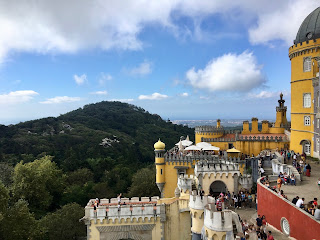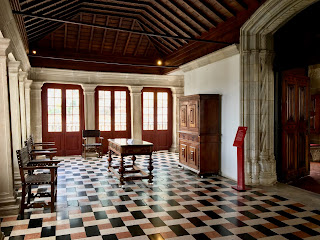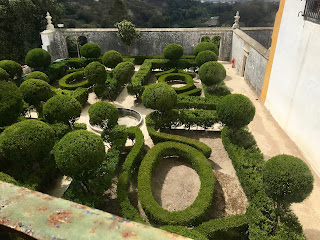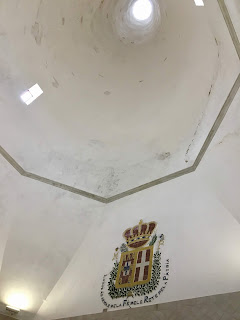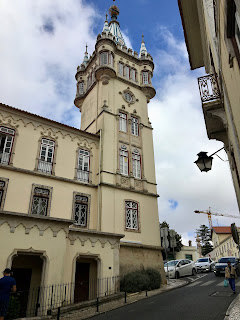Our week is filling with appointments, as we get ready to move into an apartment and start classes – so Tuesday feels a bit like the beginning of the end of summer vacation. We plan a day-trip to Sintra, a thirty-five minute train ride west of Lisbon, to check a major item off our must-see list. The tourist's highlight in Sintra is the
Palácio Nacional da Pena. As an architect, there is a curiosity, but I don't expect much in the way of a history lesson, as I understand it's totally over-the-top. We also plan to see the
Palácio Nacional de Sintra, which I assume is more of a royal palace and less of a "Cinderella castle". We hear it gets mighty crowded, so we head out early; we catch the 8:20 train from Sete Rios.
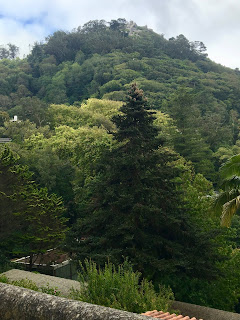

We arrive at the train station with the sparse, early crowd; the station welcomes us with azulejos tile murals. Outside the station, the small-scaled town, is just waking up. Around the end of the tracks, we stride up the hill past pastel houses with turrets and towers, and the
Castelo dos Mouros looking down. One or two other couples seem to have a similar program. At the top of a steep, short road, we find a set of stone steps, grown with ivy and moss, and a path leading into the dim, dense woods. At the switch-backs we get wide vistas down to Sintra and the Palácio, and pass through a series of circular stone guaritas.






On the other side of one of the domed doorways is a small ticket plaza, the visitor drop-off for the buses and tuk-tuks. At the turn, there is a video screen instructing us to order our tickets online to avoid the lines. Go up and then down a winding lane, we are startled by the bright yellow block of a gatehouse, and we get our first glimpse of the Palácio Nacional da Pena. By now it's just before ten, and the queue is manageable; it takes about fifteen minutes to get combo tickets for both Palácios. You have the option to take a mini-bus to the top; we note the alarming number of riders on board and enthusiastically decide to go on foot.
A comfortable uphill walk, and the path leads to a kind of plaza, right behind another bus disgorging its passengers onto the narrow street. We fight our way around the bus and finally get our first good look at the red-on-yellow towers. Selfie, tour group, selfie, tour group, and we cut our way around the crowd, and through a large key-hole portico.
The full effect of the entrance is now upon us: green tiles, blue tiles, yellow stucco, red stucco, points hanging down, points sticking up; turn through another portico, with a rustic "studded" surround; into a low, long, arch-covered walk-way. We emerge along a bright red parapet, yellow round perches topped with frosty white battlements, like the tops of chess pieces. There we find the queue to go inside (later, after noontime, the line will snake down the archway – sides clearly marked for those going inside and those staying out on the terraces).


Waiting with in queue, I try to steal a quick few minutes, and run around the "wall walk" to the opposite side, where I catch stunning views of the Castelo and into the mist all the way back to Lisbon. No photo's allowed inside,
so I've linked these. Each past occupant seems to have decorated their room in their own way. Suffice it to say it's an incoherent string of styles, scales, and details. Many of the rooms quite beautiful, many packed full of shiny trinkets, many just over-whelming – just many. As on the outside, there's overload inside.



The best feature may be the the "wall walk", though it's a narrow squeeze for two-way movement. It's not only for the views, but for the way the primary-color towers hang onto the rocks. Look at it the right way and it almost becomes modernist, as your eyes deal with only a few elemental shapes at a time. But pass back through the massive "front arch", with the menacing triton hanging onto the over-sized oriel window, between the two blue towers with gold domes atop, and all aspirations of modernism disappear into the Disney-esque cacophony (zoom to the middle of the pano). But like Disney, it sure is a lot of fun.

Just past midday, and the crowd continues to fill the plaza. We make our way out and down to sleepy Sintra-vila only to find that it, too, is awake and crammed with vacationers. Shuttle buses are side-by-side tuk-tuks and taxis in stop and start traffic. Between houses, at the viewpoints, hands with phones stick out the windows and the roofs, and just as quickly retract back in, as the vehicles stutter away.
Like balls in a pachinko machine, everyone spills out the bottom at the plaza in front of the Palácio Nacional de Sintra. Other tourists point into the hills chatting energetically: oh that's where the first car park was, oh that's where we had to turn around, oh that's where we couldn't drive past the line of buses, oh I wish we had gotten into that first car park.
I watch in horror as a guide with a tall white paddle takes a group of fifty sightseers, selfie-sticks at the ready, the wrong way up into the tiny lane. I guess they all make it, but it's hard not to flinch thinking of the crush of people.
The town itself is just as cute as a button – of course, it was built that way. Even the newer houses are trimmed with battlements and filigree, a tower here, a conical top there, with the hills and the Castelo as back-drop.
After lunch, re-charged, we enter the Palacio Nacional de Sintra. It is amazingly un-crowded. We can take our time, absorb each space, and linger on details (and photos are allowed). The rooms are beautifully and (remarkably) sparsely furnished, with plenty of signage to explain, and room to walk around some pieces. The ceilings of some rooms are painted with birds or scenes at sea, important doorways are trimmed in carved stone, floors are tiled in colorful, undemanding patterns.
I'm thinking this is all calm and design simplicity, but of course, had we arrived here first, I probably would not – this is a royal palace, the decorations are rich and full. But in contrast to where we were an hour ago, this is just easy to read, and easy to enjoy. Highlights include: the Sala dos Cisnes (Swan Room) with its painted ceiling and tile-trimmed windows, the Sala dos Brasões (Coat of Arms Room) with its azulejos murals and sparkling domed ceiling, and the Capela Palatina (Palatine Chapel) with its dove-patterned walls and Manueline tracery.
The large twin conical chimneys are exactly what they sound like: enormous hollow cones to remove heat from the kitchens. The acoustics in those rooms are balance-altering. But the only decoration in the two cavernous white cones is a single coat of arms reminding the cooks of the status of their employer.
There are no cliffs or towers, but there are wonderful verandas and balconies, with well-framed views of the town and the trees. The central interior courtyard does not have spitting grotesques, as at Pena, but instead has a tall stone marker with the national crest. A trompe l'oeil fresco of tiles has faded, but the remaining tiles are still doing their job.
The two Palácios are very different, as our experiences with them are very different. But we appreciated both, each with a story to tell. Sometimes its fun to be in full tourist mode, and sometimes its good to be given the time and space to truly enjoy a grand, old building.
We leave Sintra exhausted. We catch our last looks back at the Palácio, the towers of Sintra, and the green hills. Back on the train, our short ride back to our hotel is spent sorting and adjusting photos, reflecting on the trip, and wishing the summer would go on and on.



















